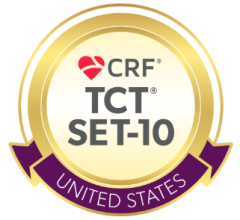
The two FDA-cleared transcatheter LAA occlusion devices on the U.S. market were compared in the SWISS-APERO and SEAL FLX trials presented at TCT 2021. Left is the Abbott Amulet device, right is the newest generation Watchman FLX device.
November 8, 2021 – SWISS-APERO is the first randomized clinical trial comparing the Abbott Amulet left atrial appendage (LAA) transcatheter occluder with the new generation Boston Scientific Watchman FLX transcatheter occluder. It compared the devices in terms of residual LAA patency after percutaneous LAA closure (LAAC), as evaluated by 45-day cardiac computed tomography angiography (CCTA). The study showed that the two devices achieve a similar rate of LAA occlusion at 45 days, but through different mechanisms. The Amulet also was associated with higher procedural complications, but similar clinical outcomes at 45-days.
Findings were reported today at 2021 Transcatheter Cardiovascular Therapeutics (TCT) annual scientific symposium of the Cardiovascular Research Foundation (CRF). The study was also published simultaneously in Circulation.[1]
Percutaneous LAAC, by accomplishing a complete LAA sealing, excludes this cavity from the circulation in order to prevent thromboembolisms in patients with non-valvular atrial fibrillation. As a consequence, the appraisal of residual LAA patency after LAAC is routinely implemented in clinical practice, typically by means of TEE. However, CCTA is more sensitive than TEE for the detection of incomplete LAA sealing and is being progressively implemented in practice. The Watchman 2.5 and the Amulet have been the two most frequently used devices for LAAC worldwide. In 2019, the second-generation Watchman FLX, was released with design iterations aimed at improving LAA sealing and facilitating implantation in complex LAA anatomies.
“In patients with high bleeding risk undergoing clinically indicated LAA closure, Amulet had similar residual LAA patency at 45-day cardiac computed tomography and lower peri-device leak rates at 45-day transesophageal echocardiography,” said Roberto Galea, M.D., Research Associate and Consultant Interventional Cardiologist with Bern University Hospital in Bern, Switzerland. “Although both devices had similar clinical outcomes at 45 days, Amulet was associated with higher procedural complications. The clinical relevance of CCTA-detected LAA patency requires further investigation.”
Between June 2018 and May 2021, 221 patients were randomly assigned to receive LAAC with an Amulet (n=111) or Watchman/FLX (n=110; this study arm included 25 patients with Watchman 2.5) device at eight centers in Europe. LAAC procedures were planned by a pre-procedural CCTA and guided by echocardiography with the aim of excluding LAA thrombus and confirming the suitability of LAA for both devices before device randomization. After successful LAAC, patients were followed at 45 days with both TEE and CCTA exams and with CCTA only at 13 months.
The primary endpoint of LAA patent appendage at 45 days by CTTA was 67.6% for Amulet compared to 70% for Watchman/FLX (RR 0.97, 95% CI 0.80-1.16, p=0.713). Intra-device leaks were 44.8% for Amulet and 23% for Watchman/FLX (p=0.001) and mixed leaks were 3.8% for Amulet compared to 14% for Watchman/FLX (p=0.010). LAA patency at 45-day TEE was 13.7% for Amulet and 27.5% for Watchman/FLX (RR 0.50, 95% CI 0.27-0.91, p=0.020). In addition, no peri-device leaks (PDLs) greater than 5mm were found with either device. Multiple PDLs were found in 2.2% of those who received the Watchman compared to none with Amulet (or Watchman FLX).
Major procedure-related complications including major bleeding (BARC 3-5) and clinically relevant pericardial effusion were higher with Amulet (9%) compared to Watchman/FLX (2.7%; RR 3.30, 95% CI 0.93-11.68, p=0.047). Clinical outcomes at 45 days post procedure (including the composite of cardiovascular death, stroke or systemic embolism, and any bleeding) were similar between the two devices.
The study was supported by local available funding and a research grant from Abbott. Galea had nothing to disclose.
Danish SEAL FLX Study Finds Watchman Performed Better Than Amulet
Another LAA occluder study comparing these devices was also reported at TCT. The SEAL FLX study was a single-center, retrospective study of 300 Danish patients. The study evaluated closure with cardiac CT and found Boston Scientific Watchman FLX device showed significantly better, complete LAA occlusion at 8 weeks compared with the Abbott Amulet device (72.6% vs. 30.5%). Peri-device leak (visible, contrast-filled gap) areas were significantly smaller with the Watchman FLX device (32mm2 at the lobe of the device, versus 90mm2 at the lobe and 93mm2 at the disc of the Amulet device, Boston Scientific said of the results.
Reference:


 October 31, 2025
October 31, 2025 









